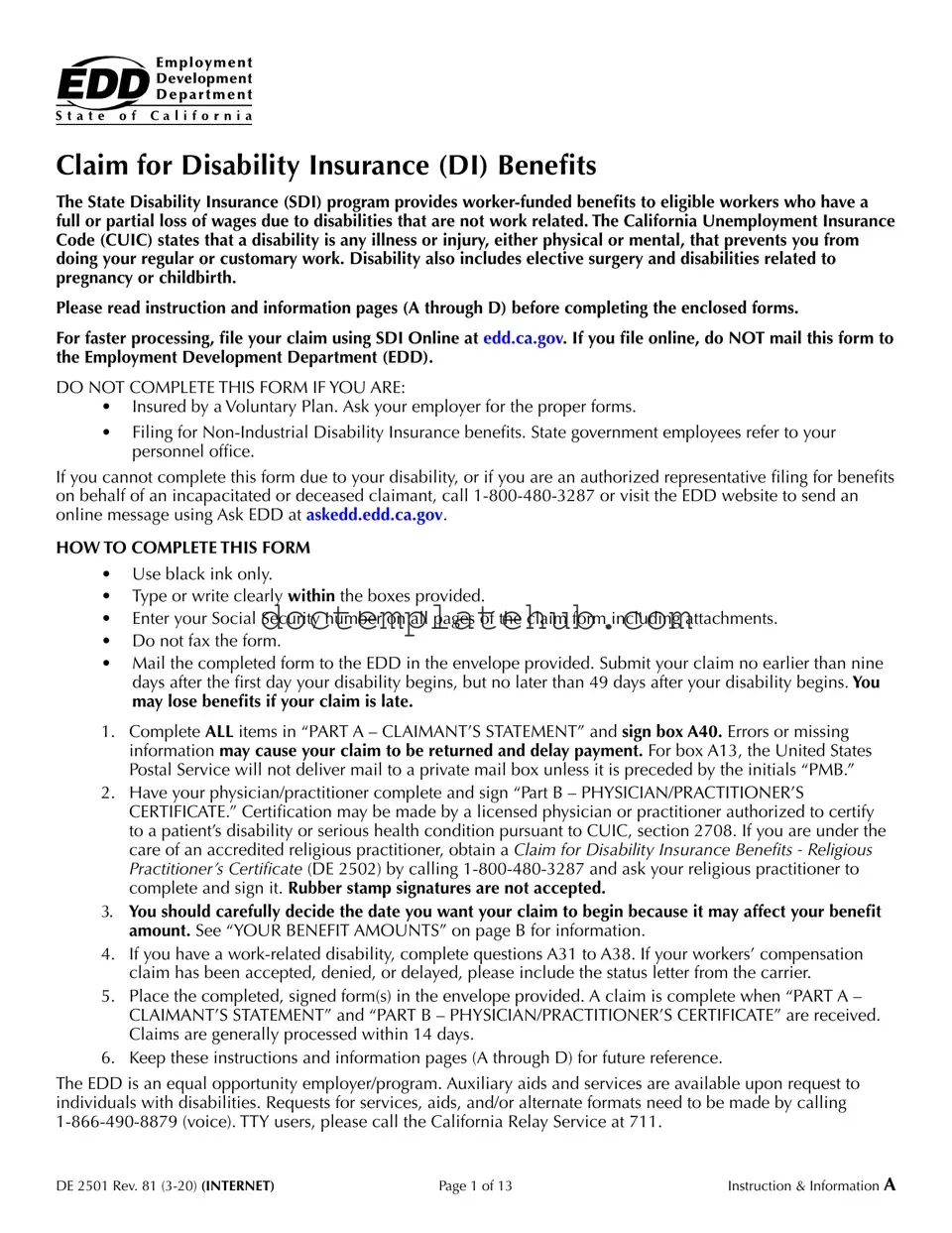The EDD DE 2501 form, known as the Claim for Disability Insurance Benefits, serves a crucial role in the process of obtaining disability benefits in California. Similar to the EDD DE 2501, the Social Security Administration's Form SSA-16, Application for Disability Insurance Benefits, is also designed to assess an individual's eligibility for disability benefits. Both forms require detailed personal information, medical history, and documentation of the disability. The primary difference lies in the governing bodies; the EDD focuses on state disability benefits, while the SSA handles federal disability benefits.
Another comparable document is the VA Form 21-526EZ, Application for Disability Compensation and Related Compensation Benefits. This form is utilized by veterans seeking disability compensation from the Department of Veterans Affairs. Like the EDD DE 2501, it requires comprehensive information regarding the applicant's service-related disabilities. Both forms aim to establish the extent of disability and its impact on the applicant's ability to work, but the VA form specifically addresses military service-related conditions.
The Workers' Compensation Claim Form, often referred to as the DWC-1 form in California, shares similarities with the EDD DE 2501 in that both are used to claim benefits related to disability. The DWC-1 form is specifically for work-related injuries or illnesses, requiring details about the incident and medical treatment received. While the EDD DE 2501 focuses on broader disability claims, the DWC-1 is limited to occupational injuries, yet both necessitate medical documentation to support the claim.
The Short-Term Disability Claim Form, commonly used by private insurance companies, is another document akin to the EDD DE 2501. This form is filled out by individuals seeking short-term disability benefits through their employer's insurance policy. Similar to the EDD DE 2501, it requires medical verification of the disability and may involve employer input. The key distinction is that short-term disability benefits are often provided by private insurers rather than state or federal programs.
The FMLA Certification of Health Care Provider form is also comparable to the EDD DE 2501. This document is used when an employee requests leave under the Family and Medical Leave Act for a serious health condition. While the focus of the FMLA form is on job protection during medical leave, it also requires medical documentation, paralleling the EDD DE 2501's need for verification of disability. Both forms emphasize the importance of medical evidence in substantiating the claim.
The Medicare Application for Disability Benefits, known as Form CMS-40B, is similar in that it allows individuals to apply for Medicare coverage due to disability. Like the EDD DE 2501, this form requires proof of the disability and personal information. The primary difference is that the Medicare form specifically addresses health insurance coverage for those who qualify based on their disability status, whereas the EDD DE 2501 is focused on financial benefits.
The State Disability Insurance (SDI) Claim Form is another document that aligns with the EDD DE 2501. This form is used by California residents to apply for state disability benefits. Both forms require information about the applicant’s medical condition and its impact on their ability to work. However, the SDI Claim Form is a more streamlined version specifically tailored for California's state disability program, whereas the EDD DE 2501 encompasses a broader range of disability claims.
Finally, the Unemployment Insurance Claim Form shares some similarities with the EDD DE 2501 in that both are used to apply for benefits during periods of inability to work. The Unemployment Insurance Claim Form focuses on individuals who are unemployed and seeking financial assistance, while the EDD DE 2501 is specifically for those unable to work due to a medical condition. Both forms require personal and employment information, but the criteria for eligibility differ significantly.
